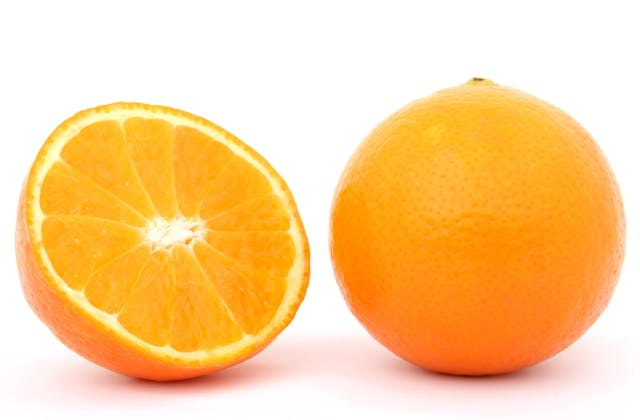
Which came first, the orange fruit of the color orange? The fruit came first. Oranges were first called oranges in the 13th century. The word orange was first used as a color in 1502.
Oranges are not just one fruit. There are over 400 different types of orange around the world, and they all have different tastes and different colors. Some of them are orange, some red, and some green. Oranges that are grown in the tropics tend to be green because they keep a lot of the chlorophyll. The oranges that we buy in the supermarket aren’t naturally as orange as they appear. They are exposed to ethylene gas and coated in wax to give them that appealing color. Ethylene gas is used to ripen fruit quickly and it is used because most fruit is shipped before it is fully ripe to make it last longer. If it was picked when it was ripe, it wouldn’t get to our shelves fast enough and would go off. Ethylene is an enzyme that is naturally present in fruit and ripens the fruit when it is activated. It softens the cell walls, which releases sugars, giving the soft and sweet taste that we get with ripe fruit. A lot of distributors have different ways to inhibit the ethylene so that the fruit can be shipped and activate it with the gas before selling.
Oranges are native to the foothills of the Himalayas, in the northeast of India, Nepal, southwest China, and north Myanmar. Fossils of oranges have been found that date back 8 million years ago. Early people probably ate them, but the first reference to an orange is only in 314 BC in China. These oranges were sour, not the sweet ones we are used to today. By about the 1st century AD, the fruit has been spread through the Arab empire by the Moors. The Moors carried it up into southern Europe as well. This orange was too sour to be eaten, but it was used in medicines. By 912 AD, it had reached through most of north Africa, the Middle East, and southern Europe. A sweet orange reached Europe by 1471 and Christopher Columbus took some of the seeds to the New World with him. It turned out that the orange plants loved the climate and thrived. Over the next few hundred years, different types, and much sweeter oranges were discovered or developed. It was also discovered that carrying oranges on long voyages could fight scurvy, an illness caused by the lack of vitamin C. Today, 75 million tons of oranges are produced a year and about 23% are produced in Brazil.
So, where did the word orange for the fruit and the word orange for the color come from? The name of the fruit came into English from French in the 13th century. The word has a long path into English, but it began as a Sanskrit word, nārańgah. It went from Sanskrit into Persian, where the word became nārang. It went from Persian into Arabic, where the word became nāranj. It went from there into Italian or French, and into English. The “n” at the start of the word was lost when it came into French through an interesting process called rebracketing. Rebracketing is when two words are joined or split to become different words. This can be seen most clearly in words that start with a vowel and go with “an”. For example, a chair but an apron. We say “an” because it starts with a vowel, but the word was originally napron. The “n” moved from in front of napron to be with the article. This happened with naranj as well. A noranage became an orange. So, we have the word orange in English in the 13th century.
The color was named after the fruit and the first usage of that in English is in 1502, when it was used to describe the color of some clothes bought for Margaret Tudor, sister of King Henry VIII. Before the word orange was used for the color, there was no word for orange. People used the word “geoluread”, which meant yellow-red. That seems strange to say, but it isn’t really. We quite often combine colors to make another color. The sea is greeny-blue, for example. When oranges started to become popular and more common, it was easy to use that name for the color. That is not an unusual thing to do because we have a lot of colors that are named after things. Apricot, peach, violet, maroon, indigo, and burgundy, to name a few. (Maroon is chestnut in French and the color was taken from that.) And this is what I learned today.
Photo by Pixabay: https://www.pexels.com/photo/orange-fruit-161559/
Sources
https://www.theguardian.com/notesandqueries/query/0,5753,-4756,00.html
https://en.wikipedia.org/wiki/Orange_(word)
https://en.wikipedia.org/wiki/Orange_(fruit)
https://en.wikipedia.org/wiki/Rebracketing
https://www.liveeatlearn.com/types-of-oranges/#sicilian-red-orange
https://www.tastemade.com/articles/8-things-you-didnt-know-about-oranges
